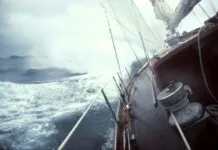The Hunter 30 built from 1974 until 1983 is a John Cherubini design, as was the companion Hunter 27. Over the course of its nine-year production run, approximately 1,000 were built. The latest 30 we examined was a 1980 model, hull #934.
The Hunter 30 is handsome from some angles but just a bit too flat in the sheer and high in the cabin top to be considered beautiful. The hull is very full to give a lot of interior room, but otherwise quite typical of the racer-cruisers of the 1970s.
The interior was originally a strong selling point for the boat. Almost every owner commented on the size of the interior – often relative to low price – when talking about their reasons for buying the 30.
Layout is conventional, with a good V-berth forward, then a head with small hanging locker opposite, settee berths on each side with a drop-leaf table in the middle, an L-shaped galley, with the sink underneath the companionway, and a quarter berth, with a tiny chart table at its head. The berths are of decent size, though a tall person will wish they were all a few inches longer.
Many of the boats have alcohol stoves (“Cooks about like a solar oven,” said one owner) that will be due for upgrading. The icebox on the boat we looked at had minimal insulation and would benefit from several more inches all around.
The deck house is high and wide, and this gives a look of spaciousness below. The white hull liner overhead helps to offset the extensive teak veneer on the bulkheads, ceilings, sole, and furniture.
There are adequate windows and hatches for adequate light inside, and opening portlights (Hunter was one of the first production boats to offer numerous opening ports as standard) to give good ventilation. If the boat has not been upgraded by the time of purchase, the new owner will probably want to add Dorade or solar vents to keep the air moving when the opening ports must be closed.
Finish below is average – typical of the low-cost production boats which depend on pre-fab components, rapidly installed in the hull. In our owner surveys, there were a great many complaints about sloppy detailing in the joinerwork, door hinges, hardware, and loose trim. Storage space is minimal, and water tankage of 35 gallons is marginally adequate for cruising.
From the Hunter 30 review. To read the complete review of this popular sailboat, in addition to ten other entry-level cruisers, purchase and download the ebook Entry-Level Sailboats, Volume Two from Practical Sailor.









































